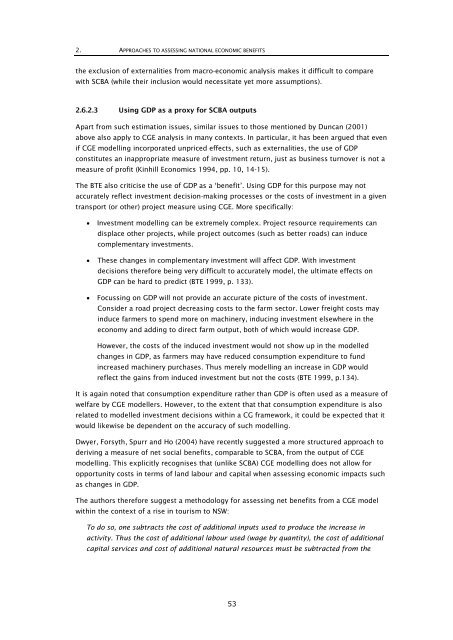Research 350 - NZ Transport Agency
Research 350 - NZ Transport Agency
Research 350 - NZ Transport Agency
Create successful ePaper yourself
Turn your PDF publications into a flip-book with our unique Google optimized e-Paper software.
2. APPROACHES TO ASSESSING NATIONAL ECONOMIC BENEFITS<br />
the exclusion of externalities from macro-economic analysis makes it difficult to compare<br />
with SCBA (while their inclusion would necessitate yet more assumptions).<br />
2.6.2.3 Using GDP as a proxy for SCBA outputs<br />
Apart from such estimation issues, similar issues to those mentioned by Duncan (2001)<br />
above also apply to CGE analysis in many contexts. In particular, it has been argued that even<br />
if CGE modelling incorporated unpriced effects, such as externalities, the use of GDP<br />
constitutes an inappropriate measure of investment return, just as business turnover is not a<br />
measure of profit (Kinhill Economics 1994, pp. 10, 14-15).<br />
The BTE also criticise the use of GDP as a ‘benefit’. Using GDP for this purpose may not<br />
accurately reflect investment decision-making processes or the costs of investment in a given<br />
transport (or other) project measure using CGE. More specifically:<br />
• Investment modelling can be extremely complex. Project resource requirements can<br />
displace other projects, while project outcomes (such as better roads) can induce<br />
complementary investments.<br />
• These changes in complementary investment will affect GDP. With investment<br />
decisions therefore being very difficult to accurately model, the ultimate effects on<br />
GDP can be hard to predict (BTE 1999, p. 133).<br />
• Focussing on GDP will not provide an accurate picture of the costs of investment.<br />
Consider a road project decreasing costs to the farm sector. Lower freight costs may<br />
induce farmers to spend more on machinery, inducing investment elsewhere in the<br />
economy and adding to direct farm output, both of which would increase GDP.<br />
However, the costs of the induced investment would not show up in the modelled<br />
changes in GDP, as farmers may have reduced consumption expenditure to fund<br />
increased machinery purchases. Thus merely modelling an increase in GDP would<br />
reflect the gains from induced investment but not the costs (BTE 1999, p.134).<br />
It is again noted that consumption expenditure rather than GDP is often used as a measure of<br />
welfare by CGE modellers. However, to the extent that that consumption expenditure is also<br />
related to modelled investment decisions within a CG framework, it could be expected that it<br />
would likewise be dependent on the accuracy of such modelling.<br />
Dwyer, Forsyth, Spurr and Ho (2004) have recently suggested a more structured approach to<br />
deriving a measure of net social benefits, comparable to SCBA, from the output of CGE<br />
modelling. This explicitly recognises that (unlike SCBA) CGE modelling does not allow for<br />
opportunity costs in terms of land labour and capital when assessing economic impacts such<br />
as changes in GDP.<br />
The authors therefore suggest a methodology for assessing net benefits from a CGE model<br />
within the context of a rise in tourism to NSW:<br />
To do so, one subtracts the cost of additional inputs used to produce the increase in<br />
activity. Thus the cost of additional labour used (wage by quantity), the cost of additional<br />
capital services and cost of additional natural resources must be subtracted from the<br />
53
















